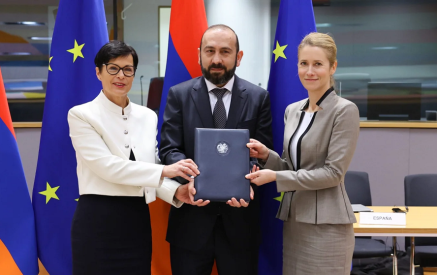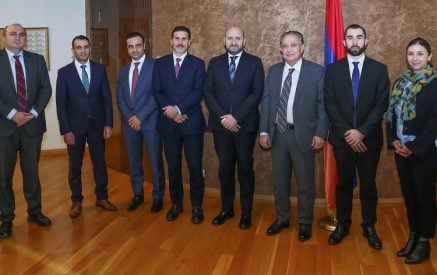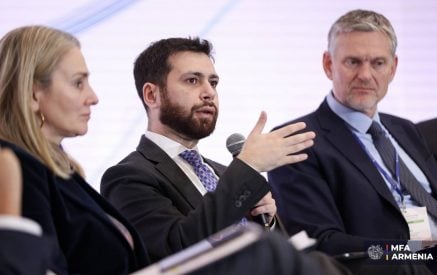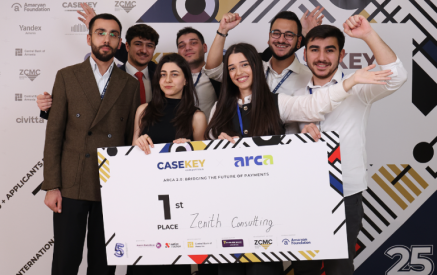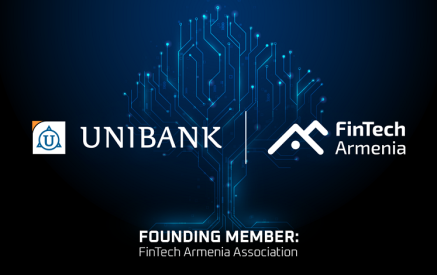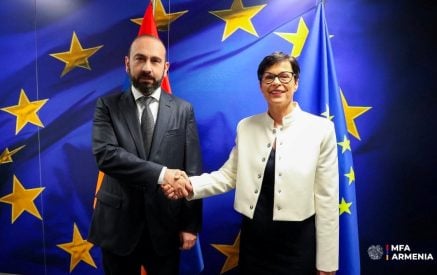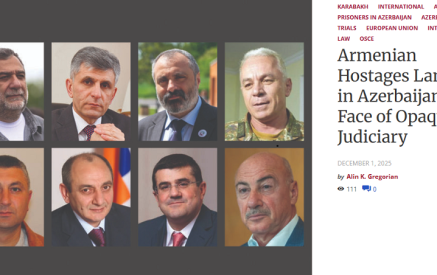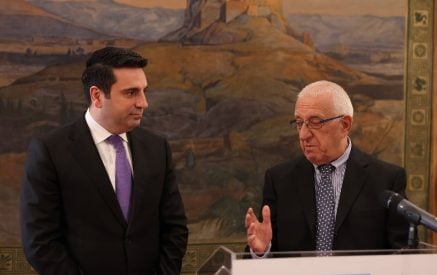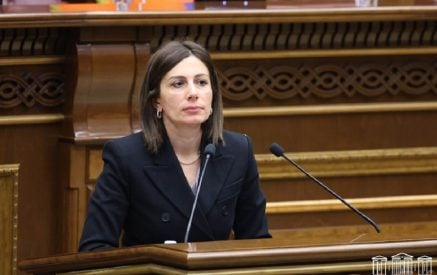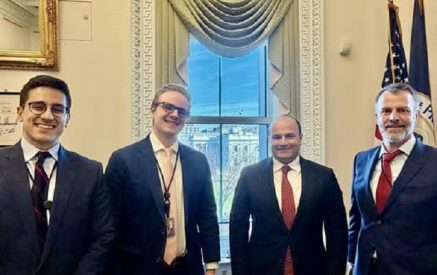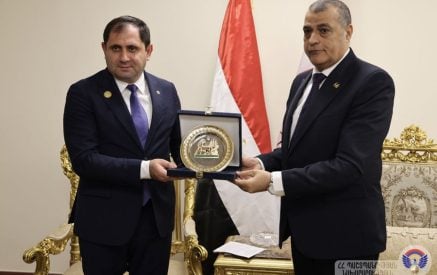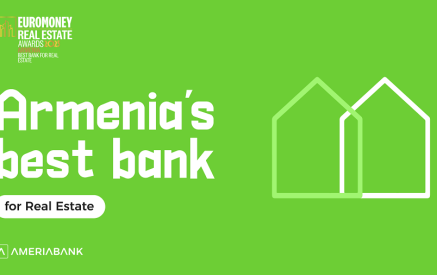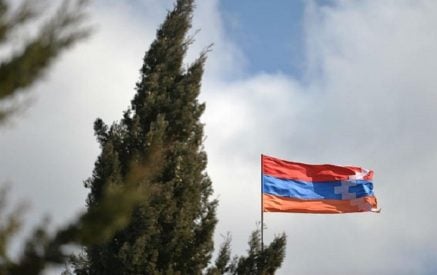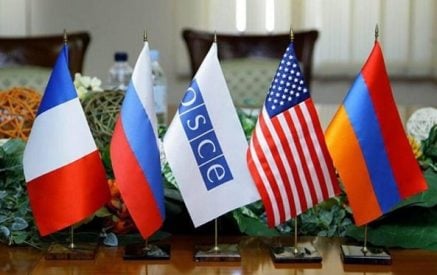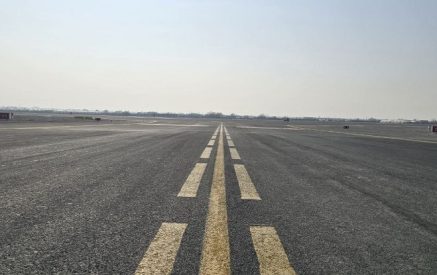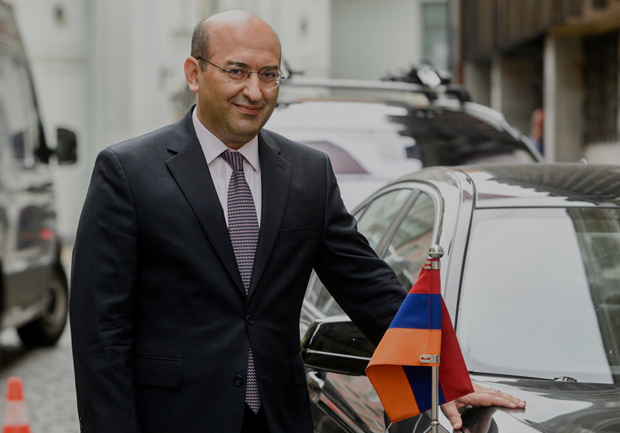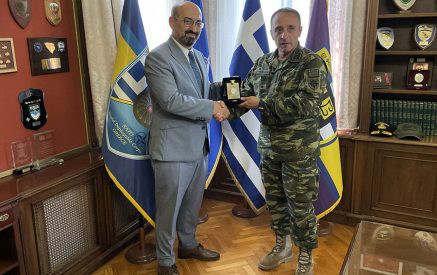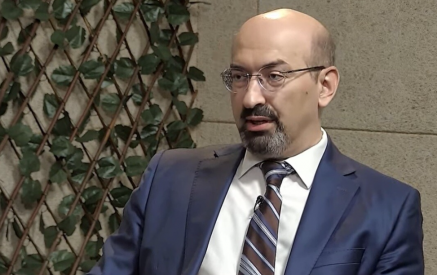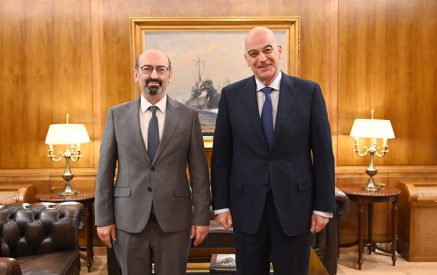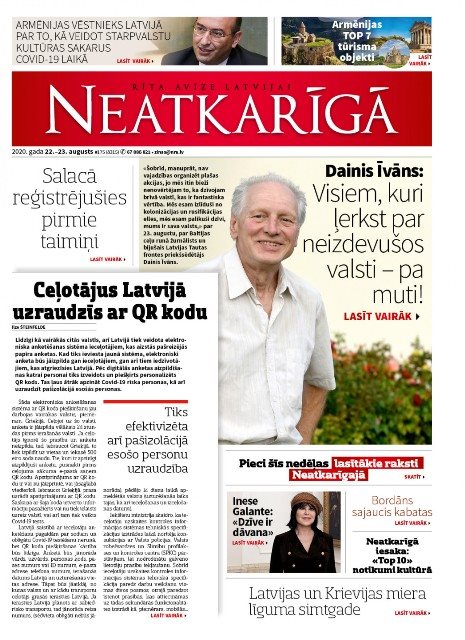Tigran Mkrtchyan, Ambassador of Armenia to Latvia answers Neatkarīgās questions
Journalist. On August 22 we mark the 28th anniversary of the establishment of diplomatic relations between Latvia and Armenia. Latvia recognized the independence of Armenia on the 8th of January, 1992, yet the diplomatic relations between Latvia and Armenia were established on the 22nd of August, 1992. How come that the establishment of diplomatic relations were completed a year after the collapse of the Soviet Union?
Tigran Mkrtchyan. To a large extent, it didn’t depend only on the governments of Latvia and Armenia. Armenia adopted her Declaration of Independence already in 1990 (August 23), but the referendum about the independence of Armenia was held on the 21st of September, 1991. Here I would like to remind you that the First Republic of Armenia was proclaimed in 1918 and was independent till 1920. Therefore, we can say that 1991 saw the restoration of the statehood of Armenia.
As for the establishment of diplomatic relations between two states, there is protocol to be observed. Meetings of the ministers of foreign affairs have to be organized etc., etc. As far as I know, the establishment of diplomatic relations with many states continued throughout the first part of the 90s. We should also take into consideration the fact that the period immediately after the collapse of the Soviet Union wasn’t easy for Armenia.
Read also
Journalist. I remember those times when already in the winter of 1991-1992 Armenia had to weather the energy blockade.
Tigran Mkrtchyan. Yes! Very difficult and complicated times, lasted until 1994. There was war in Nagorno-Karabakh. The border with Turkey was closed. The whole situation was very problematic. The warfare was taking place not only in Karabakh but also along the borders of Armenia and Azerbaijan. At that time, in many areas traversed by the pipeline that transported energy from Georgia to Armenia there were acts of sabotage. Those were very difficult times. I was still attending school. Our house got connected to electricity only for a couple of hours every day and then meals had to be cooked because there was no gas at all. I did my homework by the light of an oil lamp.
Journalist. The photos of those times capture a characteristic feature – tangles of electrical cables over every alleyway in Yerevan. Because people tried to help out each other when the electricity was cut in one neighborhood but still available a couple of blocks further.
Tigran Mkrtchyan. Yes, people always tried to help each other. Our neighbor bought an electric generator. When his wife saw me and my brother reading by the light of an oil lamp she offered our family to connect an electrical cable to their generator so that in the evenings we could have power for one electric bulb. And we could do our homework or read by comfortable lighting. The situation was normalized only by 1994/1995 when the war was finally over. I remember it well.
I had started my studies at the university and the biggest change in our daily life was the availability of electricity round the clock. In the middle of the 90s construction works resumed, but toward the end of the 1990s and the beginning of the 21st century the daily life was already much improved. I am sure that the diplomatic relations between Armenia and Latvia would have been established much earlier if we hadn’t had such difficulties.
Journalist. A characteristic feature of those times was also a mass migration from Armenia to other countries, not only Russia but also the US, Western Europe and other countries with a big Armenian diaspora.
Tigran Mkrtchyan. We should take into account that the Armenian diaspora in other countries is very substantial. It was established during several waves of migration. Already in the 19th century there was a considerable migration of Armenians. Many Armenians had to leave for other countries during the Armenian Genocide in 1915 and immediately afterwards. At first they went to the Middle East and then to the USA, South America, Canada and Western Europe. Unfortunately, many Armenians left also in the time of the re-establishment of Armenian statehood. On the other hand, the revolution in Armenia in 2018 gives us hope that many Armenians would return to their homeland, as the foundations of democracy have been established.
Journalist. How is the relationship between Armenian diaspora and the Republic of Armenia built?
Tigran Mkrtchyan. Several years ago the Ministry of Diaspora was established, with the explicit goal to build and maintain the relations with the Armenian diaspora. Many projects have been implemented. Diaspora Armenians are invited to visit the country, take part in various culture and sports events etc. Diaspora is encouraged to participate in a wide range of events in Armenia. Presently, there is a high commissioner of diaspora under the Prime Minister’s authority and their task is to coordinate the relations between Armenia and diaspora.
This is the cooperation on the governmental level but there are also other modes and levels of cooperation. An important part of this cooperation concerns relations on the level of political parties. Armenian political parties have a long history. The oldest of them were formed already around the end of the 19th century and that is why there are centers of Armenian political parties in many countries.
Nevertheless, the most important contribution to maintaining relations with the diaspora belongs to the Armenian Apostolic Church which has clergymen and churches all around the world. For example, in the Baltics recently was established a new diocese of the Armenian Apostolic Church (with headquarters in Riga). The Church is an important player in the diaspora as there are many church-organized and maintained schools, cultural and educational centers in different countries.
Journalist. Has every ethnic Armenian the right to Armenian citizenship?
Tigran Mkrtchyan. Yes! Those who come to live in Armenia have no problem with this account. When the war erupted in Syria and Iraq Armenians who lived in these countries could simply apply for Armenian citizenship, get a passport and go to Armenia. Many Armenians in these countries used this opportunity. Of course, there are also some restrictions for those Armenians who live in countries that don’t recognize dual citizenship.
Journalist. How was Armenia affected by the Covid-19 crisis?
Tigran Mkrtchyan. Regarding the quick spread of Covid-19 around the globe, Armenian authorities implemented several measures meant to contain the spread of the virus. On March 16, 2020, the government of Armenia declared a state of emergency. It is still in effect because there are new cases of infection every day and this far more than a thousand people have died from the virus. When the crisis began we received very substantial help from Lithuania that shipped to Armenia medical masks, medicine and sent a team of medical personnel to help fight the virus. Estonia, too, helped children of Armenian infected with Covid-19.
We hope that the various restrictions sooner or later will be effective and we will overcome this crisis. Unfortunately, it was the Covid-19 crisis which hampered the development of further relations between Latvia and Armenia. The regular direct flights Riga-Yerevan-Riga were due to resume in May after a long period of preparation but already in February it was clear that it won’t be possible. We hope that the flights will resume in the upcoming year. In March, the direct flight Vilnius-Yerevan-Vilnius was to be opened but again these plans had to be postponed. A few days ago I had a conversation with Wolfgang Reuss, the CEO of Air Baltic and he told me that Air Baltic plans to resume twice-weekly flights to Yerevan starting from May 2nd, 2021.
Journalist. Does it mean that also cultural events have to be postponed?
Tigran Mkrtchyan. No! On the 21st September we plan to mark the Independence Day of Armenia and the 30th anniversary of the declaration of independence of Armenia. We have invited to Latvia the “Akhtamar Quartet”, an ensemble that is based in Brussels and very well-known throughout Europe and hope that their concert will be possible. In the spring of 2021 we would like to organize a chamber music concert of the world-famous violinist Sergei Khachatryan and his sister, the piano player Lusine Khachatryan.
Before I speak about other plans for the future I would like to recall the most significant event of the Armenian-Latvian cultural cooperation in the previous year. 2019 the Radio Choir of Latvia recorded the “Liturgy” by Komitas (1869-1935), a priest of Armenian Apostolic church who is nowadays considered the most important Armenian composer. The last version of his “Liturgy” Komitas completed just a few weeks before his arrest in Constantinople on the April 24th, 1915 – this date has become the Remembrance Day for the victims of Armenian Genocide.
In 2019, Vache Sharafyan, a contemporary Armenian composer transcribed Komitas work – which was originally meant for the male choir – adapting it for mixed choir. The Latvian Radio Choir under the guidance of the conductor Sigvards Klava, in their turn, sung the “Liturgy” in a marvelous concert dedicated to the 150th anniversary of Komitas. Shortly afterwards they also recorded the “Liturgy” as a CD album which is already gathering reviews from most prominent critics. Reviews about the CD have been published even by such newspapers as “Independent”, “Guardian” etc.
This year we plan to organize the presentation of the Latvian translation of Franz Werfel’s “Forty Days of Musa Dagh” which was recently published by the publishing house Jāņa Rozes apgāds.
The novel tells about the Armenian Genocide in 1915, yet it doesn’t concentrate only on the massacre and the tragedy of the victims but on one of the few episodes of resistance. It is a story about heroism and involuntary heroes, a chronicle of the resistance of the doomed and at the same time about hope and faith until the very end. The publication of this book was supported by the EU program “Creative Europe”, by the government of Austria, Ministry of Education, Science, Culture and Sport of Armenia (which provided financial support for the realization of Komitas “Liturgy” project) and the Armenian diaspora members from Latvia (Mkhitar Mkhitaryan, Ovik Mkrtchyan).
Journalist. Many countries already have opened their cities and tourist attractions. What about Armenia?
Tigran Mkrtchyan. Since 12th of August we have lifted the ban of travel to Armenia by airplane. EU citizens don’t need a visa to visit Armenia, i. e. people from Latvia can travel to Armenia whenever they wish. Nevertheless, taking into account the precaution to be observed because of Covid-19 and also the wide-spread reluctance to travel I think that visit to Armenia probably would be postponed, maybe to May 2021 when Air Baltic is due to resume direct flights to Yerevan.
Journalist. If real travel is not yet possible, how about a virtual tour? Please name five most interesting tourist attractions which should be visited by Latvian travelers!
Tigran Mkrtchyan. There are definitely more than five interesting and beautiful sites in Armenia. But if I have to name just five then the first would be the Holy See of St. Etchmiadzin in Vagharshapat city. Every visitor should see the cathedral of Etchmiadzin. Built in 301, it is the most ancient Christian church still in existence. There are also other churches, museums and other sites in Etchmiadzin where one can learn a lot about the history of Christianity.
The second site would be Lake Sevan, the biggest lake in Armenia and one of the biggest mountain lakes in the world, situated almost 2000 m above sea level. Sevan can be enjoyed not only in summer when one can have a relaxing swim after an arduous hike, it is a great place to visit at any time of the year – for example to taste the famous trout of Sevan.
The third most striking site would be the monastery of Khor Virap, one of the most important pilgrimage sites in Armenia. The view of the sacred Mount Ararat from Khor Virap is breath-taking. The visitors can also see the underground gaol (dungeon), the place where was imprisoned St. Gregory the Illuminator, who helped Armenia become Christian.
Another site to visit is the monastery of Tatev which can be reached by the world’s longest cable way according to the Guinness World Records – 5,7 km. Not far from Yerevan there is the Geghard monastery (10th‒13th century), which was first established in the 4th century, and also the ruins of Garni, an ancient Zoroastrian temple, built two thousand years ago. In the 4th century when Armenia was Christianized, all the other pagan temples were demolished but Garni survived until the 17th century and then collapsed in an earthquake. Later the temple was reconstructed and nowadays it is the only Graeco-Roman structure still standing in Armenia.
Last but not least – Yerevan, the capital of Armenia, home to the most important museums, architectural and historical monuments, recreation sites. Here I will name only one of many Yerevan’s attractions – Matenadaran, the repository of ancient manuscripts. Yerevan has also a fabulous night life and world-class jazz clubs.
Those Latvian people who still remember Armenia as the producer of the most perfect brandy in the world I can tell that nowadays Armenia has started to produce also wines that can compete with the best of the best.
In thirty years, Armenian winemakers from Argentina, Lebanon and other countries that returned to their ancestral homeland managed to establish a truly excellent wine sector. While travel to Armenia is still problematic I would like to invite you to experience the aura and the unique fragrance of Armenian mountains, forests and rivers taking a sip of a good Armenian brandy or red wine.
***
In parallel with the interview, the periodical in a separate publication presented 7 most interesting tourism attractions of Armenia. It is available at:
https://neatkariga.nra.lv/lasamgabali/322765-armenijas-top7-turisma-objekti?p=1
Main caption: Ambassador of Armenia to Latvia Tigran Mkrtchyan: © Romāns KOKŠAROVS, F64 Photo Agency



























